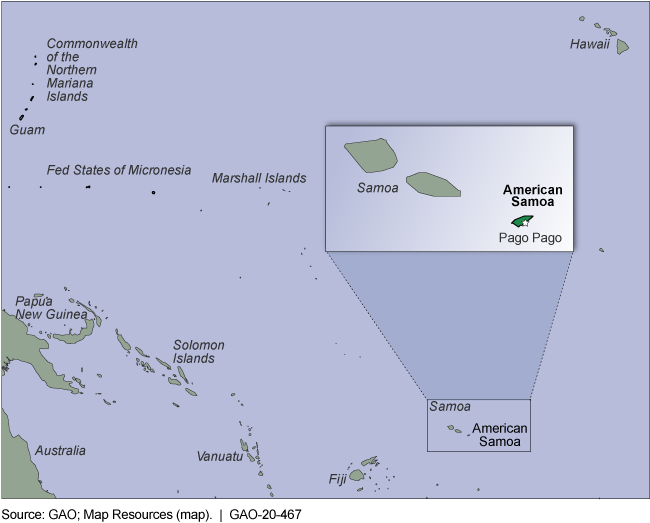American Samoa: Economic Trends, Status of the Tuna Canning Industry, and Stakeholders' Views on Minimum Wage Increases
Fast Facts
The statutory federal minimum wage has not applied in American Samoa for many years. In 2007, Congress approved increasing the territory's minimum wages, but later delayed or reduced the increases. Minimum wages are now scheduled to rise to the current federal level by 2036.
American Samoa’s economy depends on the tuna canning industry—but its only cannery is in financial trouble.
We interviewed stakeholders about a minimum wage increase. Territory officials favor a wage the economy can support. The Chamber of Commerce favors a delay. Employers and workers note benefits and challenges.

Map showing American Samoa east of Fiji and south of Hawaii
Highlights
What GAO Found
American Samoa's economy largely contracted during the past decade. Adjusted for inflation, gross domestic product declined by 18.2 percent from 2007 to 2017, and increased by 2.2 percent in 2018 (see fig.). While American Samoa employment varied by year from 2007 to 2018, workers' inflation-adjusted earnings generally declined. American Samoa's economy continues to depend on the territorial government and tuna canning industry as key sectors. Changes in government spending and the tuna canning industry, including cannery closures, have impacted American Samoa's economy. To reduce the territory's dependence on the government and the tuna canning industry, the American Samoa government continues its efforts to diversify the economy.
American Samoa Real Gross Domestic Product, 2007-2018, Percentage Change

Note: Bureau of Economic Analysis calculates percentage changes using unrounded data.
American Samoa's tuna canning industry faces multiple challenges, including increased competition and minimum wage increases, which led to cannery closures from 2007 to 2018. The companies that experienced the closures explained that minimum wage increases were a factor in the closures, but not a main factor. With the closures, employment of cannery workers decreased but inflation-adjusted earnings of cannery workers who maintained their jobs increased. StarKist Co. now operates the single remaining cannery in American Samoa, StarKist Samoa, but faces financial challenges. In addition to increased competition and labor market challenges, the industry faces other challenges, such as lower wages relative to those in American Samoa for cannery workers in other countries. However, American Samoa offers the tuna canning industry advantages relative to the U.S. mainland and other countries, including lower wages compared to those in the U.S. mainland as well as duty-free access to the U.S. canned tuna market, according to StarKist Samoa officials.
The American Samoa government and the American Samoa Chamber of Commerce (the Chamber) view the minimum wage increases as conflicting with sustainable economic development, but employers and workers GAO interviewed noted benefits and challenges presented by minimum wage increases. The government supports setting a minimum wage that the economy can support, while the Chamber supports delaying minimum wage increases for the cannery. Employers and workers GAO interviewed noted a potential positive impact on the livelihood of workers but a potential negative impact on the remaining cannery, among other things.
Why GAO Did This Study
In 2007, Congress passed legislation that established a schedule of periodic increases that would have raised all minimum wages in American Samoa to the current federal level ($7.25 per hour) by 2016. However, subsequent legislation has postponed or reduced scheduled minimum wage increases. The most recent minimum wage increase in American Samoa occurred on September 30, 2018, but all minimum wages in American Samoa are not scheduled to converge with the current federal level until 2036.
Pub. L. No. 111-5, enacted in February 2009, included a provision for GAO to report periodically on the economic impact of minimum wage increases in American Samoa. This report examines (1) economic trends including changes in employment and earnings since the minimum wage increases in American Samoa began in 2007, (2) the status of the tuna canning industry, and (3) stakeholder views on the minimum wage increases. GAO analyzed federal and American Samoa data for 2016 through 2018, and interviewed employers and workers in American Samoa selected on the basis of employment levels, among other criteria.
Commenting on a draft of this report, the American Samoa government suggested creating a committee to set minimum wages in the territory and a moratorium on minimum wage increases until the committee is formed. The Department of the Interior suggested GAO conduct further study, including on the use of a committee to set minimum wages. The suggested further study was beyond the scope of this report.
For more information, contact David Gootnick at (202) 512-3149 or gootnickd@gao.gov.
